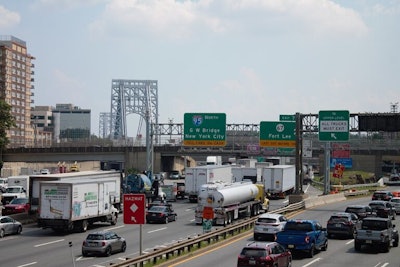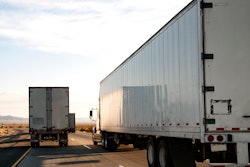
The interchange of Interstate 95 and State Route 4 at the George Washington Bridge in Fort Lee, New Jersey, once again ranks as the most congested freight bottleneck in the country, according to the American Transportation Research Institute's 14th annual list of the most congested bottlenecks for trucks in America released today.
The remaining Top 10 bottlenecks include:
2. Chicago: I-294 at I-290/I-88
3. Houston: I-45 at I-69/US 59
4. Atlanta: I-285 at I-85 (North)
5. Nashville: I-24/I-40 at I-440 (East)
6. Atlanta: I-75 at I-285 (North)
5. Los Angeles: SR 60 at SR 57
6. Cincinnati: I-71 at I-75
7. Houston: I-10 at I-45
8. Atlanta: I-20 at I-285 (West)
“Delays inflicted on truckers by congestion are the equivalent of 436,000 drivers sitting idle for an entire year,” said ATRI President and COO Rebecca Brewster. “These metrics are getting worse, but the good news is that states do not need to accept the status quo. Illinois was once home to the top bottleneck in the country, but following a sustained effort to expand capacity, the Jane Byrne Interchange in Chicago no longer ranks in the top 10. This data gives policymakers a road map to reduce chokepoints, lower emissions, and drive economic growth.”
The 2025 Top Truck Bottleneck List measures the level of truck-involved congestion at more than 325 locations on the national highway system. The analysis, based on an extensive database of freight truck GPS data, uses several customized software applications and analysis methods, along with terabytes of data from trucking operations to produce a congestion impact ranking for each location.
ATRI’s analysis, which utilized data from 2024, found traffic conditions continue to deteriorate from recent years, in some instances due to work zones resulting from increased infrastructure investment. Average rush hour truck speeds were 34.2 MPH, down 3 percent from the previous year. Among the top 10 locations, average rush hour truck speeds were 29.7 MPH.
In addition to the loss of time and money, these delays waste fuel – with trucks burning an estimated 6.4 billion gallons of diesel fuel and producing more than 65 million metric tons of additional carbon emissions while stuck in traffic jams, according to ATRI's research.
For access to the full report, including detailed information on each of the 100 top congested locations, please visit ATRI's website here.







